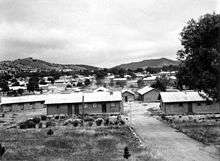Post-war immigration to Australia
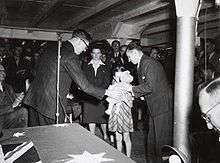
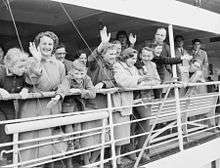
Post-war immigration to Australia deals with migration to Australia since the end of World War II. In the immediate aftermath of World War II, Ben Chifley, Prime Minister of Australia (1945–1949), established the federal Department of Immigration to administer a large-scale immigration program. Chifley commissioned a report on the subject which found that Australia was in urgent need of a larger population for the purposes of defence and development and it recommended a 1% annual increase in population through increased immigration.[1]
The first Minister for Immigration, Arthur Calwell, promoted mass immigration with the slogan "populate or perish".[2] Calwell coined the term "New Australians" in an effort to supplant such terms as pommy (Englishman) and wog.
The 1% target remained a part of government policy until the Whitlam Government (1972–1975), when immigration numbers were substantially cut back, only to be restored by the Fraser Government (1975–1982).[1]
Some 4.2 million immigrants arrived between 1945 and 1985, about 40 per cent of whom came from Britain and Ireland.[3] By 2007, some 6.5 million people have migrated to Australia since 1945.[4] This total comprises 3.35 million males and 3.15 million females. This represents a significant proportion of the overall population increase experienced by Australia in that time, having gone from 7 million in 1945 to the present total of over 23 million.[4] 182,159 people were sponsored by the International Refugee Organisation (IRO) from the end of World War II up to the end of 1954 to resettle in Australia from Europe—more than the number of convicts transported to Australia in the first 80 years after European settlement.[5]
"Populate or perish" policy
The Chifley years
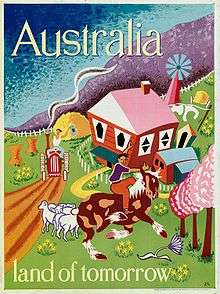
Following the attacks on Darwin and the associated fear of Imperial Japanese invasion in World War II, the Chifley Government commissioned a report on the subject which found that Australia was in urgent need of a larger population for the purposes of defence and development and it recommended a 1% annual increase in population through increased immigration.[1] In 1945, the government established the federal Department of Immigration to administer the new immigration program. The first Minister for Immigration was Arthur Calwell. An Assisted Passage Migration Scheme was also established in 1945 to encourage Britons to migrate to Australia. The government's objective was summarised in the slogan "populate or perish". Calwell stated in 1947, to critics of mass immigration from non-British Europe: "We have 25 years at most to populate this country before the yellow races are down on us."
The post-war immigration program of the Chifley Government gave them preference to migrants from Great Britain, and initially an ambitious target was set of nine British out of ten immigrants.[1] However, it was soon apparent that even with assisted passage the government target would be impossible to achieve given that Britain's shipping capacity was quite diminished from pre-war levels. As a consequence, Calwell looked further afield to maintain overall immigration numbers, and this meant relying on the IRO refugees from Eastern Europe, with the USA providing the necessary shipping.[1] Many Eastern Europeans were refugees from the Red Army and thus mostly anti-Communist and so politically acceptable.[6]
Menzies years
The 1% target survived a change of government in 1949, when the Menzies Government succeeded Chifley's. The new Minister of Immigration was Harold Holt (1949–56).
The British component remained the largest component of the migrant intake until 1953.[1] Between 1953 and late 1956, migrants from Southern Europe outnumbered the British, and this caused some alarm in the Australian government, causing it to place restrictions on Southern Europeans sponsoring newcomers and to commence the "Bring out a Briton" campaign. With the increase in financial assistance to British settlers provided during the 1960s, the British component was able to return to the top position in the overall number of new settlers.[7]
Hundreds of thousands of displaced Europeans migrated to Australia and over 1,000,000 Britons immigrated with financial assistance.[8] The migration assistance scheme initially targeted citizens of Commonwealth countries; but it was gradually extended to other countries such as the Netherlands and Italy. The qualifications were straightforward: migrants needed to be in sound health and under the age of 45 years. There were initially no skill requirements, although under the White Australia policy, people from mixed-race backgrounds found it very difficult to take advantage of the scheme.[9]
Migration brought large numbers of southern and central Europeans to Australia for the first time. A 1958 government leaflet assured voters that unskilled non-British migrants were needed for "labour on rugged projects ...work which is not generally acceptable to Australians or British workers."[10] The Australian economy stood in sharp contrast to war-ravaged Europe, and newly arrived migrants found employment in a booming manufacturing industry and government assisted programmes such as the Snowy Mountains Scheme. This hydroelectricity and irrigation complex in south-east Australia consisted of sixteen major dams and seven power stations constructed between 1949 and 1974. It remains the largest engineering project undertaken in Australia. Necessitating the employment of 100,000 people from over 30 countries, to many it denotes the birth of multicultural Australia.[11]
In 1955 the one-millionth post-war immigrant arrived in Australia. Australia's population reached 10 million in 1959, up from 7 million in 1945.
End to the White Australia policy
In 1972, Whitlam Government (1972-1975) adopted a completely non-discriminatory immigration policy, effectively putting an end to the White Australia policy. However, the change occurred in the context of a substantial reduction in the overall migrant intake. During the Fraser Government (1975-1982) there was a final end to the White Australia policy but there was an increasing intake of Vietnamese refugees in the aftermath of the end of the Vietnam War, and Australia experienced the largest intake of Asian immigrants since the arrival of the Chinese gold miners during the gold rush of the 1850s and 60s. In 1983, the level of British immigration was below the level of Asian immigration for the first time in Australian history.[1]
International agreements
Financial assistance was an important element of the post war immigration program and as such there were a number of agreements in place between the Australian government and various governments and international organisations.[12]
- United Kingdom - free or assisted passages.[12] Immigrants under this scheme became known as Ten Pound Poms.
- assisted passages for ex-servicemen of the British Empire and the United States.[12] This scheme later covered ex-servicemen or resistance fighters from the Netherlands, Norway, France, Belgium and Denmark.[12]
- an agreement with the International Refugee Organization (IRO) to settle at least 12,000 displaced people a year from camps in Europe.[12] Australia accepted a disproportionate share of refugees sponsored by IRO in the late 1940s and early 1950s.[13]
- formal migration agreements, often involving the grant of assisted passage, with the United Kingdom, Malta, the Netherlands, Italy, West Germany, Turkey and Yugoslavia.[12]
- there were also informal migration agreements with a number of other countries including Austria, Greece, Spain, and Belgium.[12]
Timeline
| Period | Events |
|---|---|
| 1947 | Australia's first migrant reception centre opened at Bonegilla, Victoria - the first assistant migrants were received there in 1951.[14] |
| 1948 | Australia signed Peace treaties with Italy, Romania, Bulgaria and Hungary and accepted immigrants from these countries.[2] |
| 1949 | In 1949 assisted arrivals reached more than 118,800, four times the 1948 figure[2]
In August Australia welcomed its 50,000th "New Australian" — or rather, the 50,000th displaced person sponsored by the IRO and to be resettled in Australia. The child was from Riga, Latvia.[13][15] Work began on the Snowy Mountains Scheme - a substantial employer of migrants: 100,000 people were employed from at least 30 different nationalities. Seventy percent of all the workers were migrants.[16] |
| 1950 | Net Overseas Migration was 153,685, the third highest figure of the twentieth century.[2][17] |
| 1951 | The first assisted migrants received at the Bonegilla Migrant Reception and Training Centre.[14] By 1951, the government had established three migrant reception centres for non-English speaking displaced persons from Europe, and twenty holding centres, principally to house non-working dependants, when the pressure of arrival numbers on the reception centres was too great to keep families together.[14] |
| 1952 | The IRO was abolished and from then most refugees who resettled in Australia during the 1950s were brought here under the auspices of the Intergovernmental Committee for European Migration (ICEM).[13] |
| 1954, | The 50,000th Dutch migrant arrived.[18] |
| 1955 | Australia’s millionth post-war immigrant arrived.[2] She was a 21-year-old from the United Kingdom and newly married.[19][20] |
| 1971 | Migrant camp at Bonegilla, Victoria closed - some 300,000 migrants had spent time there.[14] |
Settler arrivals by top 10 countries of birth
| Birthplace | No. of arrivals July 1949 - June 2000[21] | July 1949 - June 1959[22] | July 1959 - June 1970[23] | July 1970 - June 1980 |
|---|---|---|---|---|
| 1 United Kingdom & Ireland | 1,787,449 (31.6%) | 419,946 (33.5%) | 654,640 (45.3%) | 342,373 (35.8%) |
| 2 Italy | 390,810 (6.9%) | 201,428 (16.1%) | 150,669 (10.4%) | 28,800 (3.0%) |
| 3 New Zealand | 371,683 (6.6%) | 29,649 (2.4%) | 30,341 (2.1%) | 58,163 (6.1%) |
| 4 Germany | 255,930 (4.5%) | 162,756 (13.0%) | 50,452 (3.5%) | not in top 10 |
| 5 Greece | 220,603 (3.9%) | 55,326 (4.4%) | 124,324 (8.6%) | 30,907 (3.2%) |
| 6 Yugoslavia (Yugoslavia recorded until 1994 –95 inclusive) | 206,554 (3.7%) | not in top 10 | 94,555 (6.5%) | 61,283 (6.4%) |
| 7 Vietnam | 170,990 (3.0%) | not in top 10 | not in top 10 | 30,633 (3.2%) |
| 8 Netherlands | 161,298 (2.9%) | 100,970 (8.1%) | 36,533 (2.5%) | not in top 10 |
| 9 Hong Kong | 108,181 (1.9%) | not in top 10 | not in top 10 | not in top 10 |
| 10 Philippines | 103,310 (1.8%) | not in top 10 | not in top 10 | not in top 10 |
| Malta | not in top 10 | 38,113 (3.0%) | 28,916 (2.0%) | not in top 10 |
| Austria | not in top 10 | 33,730 (2.7%) | not in top 10 | not in top 10 |
| USA | not in top 10 | 16,982 (1.4%) | 20,467 (1.4%) | 27,769 (2.9%) |
| Egypt | not in top 10 | 13,430 (1.1%) | not in top 10 | not in top 10 |
| Spain | not in top 10 | not in top 10 | 17,611 (1.2%) | not in top 10 |
| Lebanon | not in top 10 | not in top 10 | not in top 10 | 32,207 (3.4%) |
| Turkey | not in top 10 | not in top 10 | not in top 10 | 18,444 (1.9%) |
| India | not in top 10 | not in top 10 | not in top 10 | 17,910 (1.9%) |
| Top Ten Total | 3,770,348 (66.8%) | 1,072,330 (85.6%) | 1,208,508 (83.6%) | 648,489 (67.8%) |
| Other | 1,870,290 (33.2%) | 180,753 (14.4%) | 236,848 (16.4%) | 308,280 (32.2%) |
| Total Settler Arrivals | 5,640,638 (100.0%) | 1,253,083 | 1,445,356 | 956,769 |
Migrant reception and training centres
On arrival in Australia, many migrants went to migrant reception and training centres where they learned some English while they looked for a job. The Department of Immigration was responsible for the camps and kept records on camp administration and residents.[24] The migrant reception and training centres were also known as Commonwealth Immigration Camps, migrant hostels, immigration dependants' holding centres, migrant accommodation, or migrant workers' hostels.[25][26]
Australia's first migrant reception centre opened at Bonegilla, Victoria near Wodonga in December 1947. When the camp closed in 1971, some 300,000 migrants had spent time there.[14]
By 1951, the government had established three migrant reception centres for non-English speaking displaced persons from Europe, and twenty holding centres, principally to house non-working dependants, when the pressure of arrival numbers on the reception centres was too great to keep families together.[14] The purpose of reception and training centres was to:
provide for general medical examination and x-ray of migrants, issue of necessary clothing, payment of social service benefits, interview to determine employment potential, instruction in English and the Australian way of life generally.[14]
The centres were located throughout Australia (dates are those of post office opening and closing[27]).
Queensland
- Stuart[24]
- Wacol[24]
- Yungaba Immigration Centre (known today as Yungaba House)
New South Wales
- Bathurst (1948 to 1952)[28]
- Bradfield Park, now Lindfield[25]
- Chullora, a suburb of Sydney (1 August 1949 to 31 October 1967)
- Greta, near Newcastle (1 June 1949 to 15 January 1960)
- Uranquinty (1 December 1948 to 31 March 1959)
Other hostels in New South Wales included Adamstown, Balgownie, Bankstown, Berkeley, Bunnerong, Burwood, Cabramatta, Cronulla, Dundas, East Hills, Ermington, Goulburn, Katoomba, Kingsgrove, Kyeemagh, Leeton, Lithgow, Mascot, Matraville, Mayfield, Meadowbank, Nelson Bay, North Head, Orange, Parkes, Port Stephens, Randwick, St Marys, Scheyville, Schofields, Unanderra, Villawood, Wallerawang and Wallgrove.[26]
Victoria
South Australia
Western Australia
- Northam Holden (15 August 1949 to 30 June 1957)
- Graylands[24]
- Cunderdin[24]
- Point Walter[30]
Breakdown of arrivals by decade
- Immigrants who arrived in Australia (by decade of arrival) as a percentage of the total population, subdivided geographically by statistical local area, as of the 2011 census
 1941-1950
1941-1950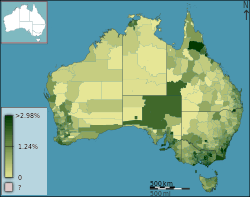 1951-1960
1951-1960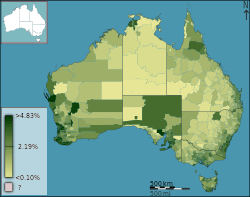 1961-1970
1961-1970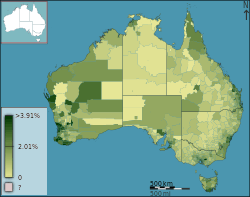 1971-1980
1971-1980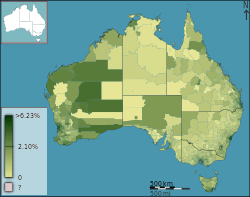 1981-1990
1981-1990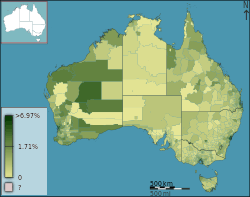 1991-2000
1991-2000
Since 1950 Australia has experienced average arrivals of around one million per decade, with the totals in the earlier decades being slightly above the totals in the more recent decades. Current statistics suggest that one million will be reached again in the current decade.[4] The breakdown by decade is as follows:
- 1.6 million between October 1945 and 30 June 1960;
- about 1.3 million in the 1960s;
- about 960.000 in the 1970s;
- about 1.1 million in the 1980s; and
- over 900,000 in the 1990s.[4]
The highest number of arrivals in any one year since World War II was 185,099 in 1969-70 and the lowest was 52,752 in 1975-76.[4]
| Period | Migration Programme[31] [32] |
|---|---|
| 1998–99 | 68 000 |
| 1999–00 | 70 000 |
| 2000–01 | 76 000 |
| 2001–02 | 85 000 |
| 2002–03 | 108,070 |
| 2003-2004 | 114,360 |
| 2004-2005 | 120,060 |
| 2005 | 142,933 |
| 2006 | 148,200 |
| 2007 | 158,630 |
| 2008 | 171,318 |
| 2011 | 185,000 |
| 2012 | 190,000 |
Demography as at 2006 for non-English speaking ethnic groups
In the 2006 census, birthplace was enumerated as was date of arrival in Australia for those not born in Australia. For the major immigrant groups enlarged by the arrival of immigrants to Australia after World War II, they are still major demographic groups in Australia:
| Ethnic group | Persons born overseas[33] | Arrived 1979 or earlier[33] | Aged 60 years and over[33]
This compares with 18% of Australian residents |
Australian citizens[33] |
|---|---|---|---|---|
| Italian Australian | 199,124 | 176,536 or 89% | 63% | 157,209 or 79% |
| Greek Australian | 109,990 | 94,766 or 86% | 60% | 104,950 or 95% |
| German Australian | 106,524 | 74,128 or 79% | 46% | 75,623 or 71% |
| Dutch Australian | 78,924 | 62,495 or 79% | 52% | 59,502 or 75% |
| Croatian Australian | 50,996 | 35,598 or 70% | 43% | 48,271 or 95% |
Not all of those enumerated would have arrived as post-war migrants, specific statistics as at 2006 are not available.
See also
References
- 1 2 3 4 5 6 7 Price, CA (September 1998). "POST-WAR IMMIGRATION: 1945-1998". Journal of the Australian Population Association. 15 (2): 17.
- 1 2 3 4 5 "Immigration to Australia During the 20th Century – Historical Impacts on Immigration Intake, Population Size and Population Composition – A Timeline" (pdf of 7 pages). Department of Immigration and Citizenship (Australia). 2001. Retrieved 2008-07-18.
- ↑ Jan Bassett (1986) pp. 138–39
- 1 2 3 4 5 "Fact Sheet 2 - Key Facts in Immigration". Department of Immigration and Citizenship (Australia). 2008. Retrieved 2008-07-21.
- ↑ Tündern-Smith, Ann (2008-05-23). "What is the Fifth Fleet?". Fifth Fleet Press. Retrieved 2008-07-21.
- ↑ J. Franklin, 'Calwell, Catholicism and the origins of multicultural Australia', 2009.
- ↑ "Look at Life - Immigration to Australia 1950s 1960s" on YouTube
- ↑ "Ten Pound Poms". ABC Television (Australia). 1 November 2007.
- ↑ "Ten Pound Poms". Museum Victoria. 10 May 2009. Archived from the original on 17 January 2010.
- ↑ cited in Michael Dugan and Josef Swarc (1984) p. 139
- ↑ "The Snowy Mountains Scheme". Cultureandrecreation.gov.au. 20 March 2008. Retrieved 14 July 2011.
- 1 2 3 4 5 6 7 "Fact Sheet 4 - More than 60 Years of Post-war Migration". Department of Immigration and Citizenship (Australia). 2007. Retrieved 2008-07-18.
- 1 2 3 Neumann, Klaus (2003). "Providing a 'home for the oppressed'? Historical perspectives on Australian responses to refugees". Australian Journal of Human Rights. Australian Human Rights Centre: Faculty of Law at the University of New South Wales. 9 (2). ISSN 1323-238X. Retrieved 2008-07-19.
- 1 2 3 4 5 6 7 "Bonegilla Migrant Centre - Camp Block 19". Australian Heritage list. Aussie Heritage. 2007. Archived from the original on 9 August 2008. Retrieved 20 July 2008.
- ↑ "Photograph of Mr Arthur Calwell with the Kalnins family - the 50,000th New Australian - CU914/1 (1949)". National Archives of Australia. Retrieved 2008-07-20.
- ↑ "The Snowy Mountains Scheme". Culture and recreation portal. Department of the Environment, Water, Heritage and the Arts (Australia). 2008. Retrieved 2008-07-20.
- ↑ 1950 = Third highest figure per Department of Immigration timeline: In 1919 Net Overseas Migration was 166,303 when troops returned from World War I and in 1988 it was 172,794.
- ↑ "Photograph of MMigrant Arrivals in Australia - 50,000th Dutch migrant, arrives in Australia aboard the SIBAJAK. Miss Scholte presents Australia's Minister for Immigration, Mr. H. E. Holt, with inscribed Delft plates, which she brought as goodwill gifts from Netherlands Government (1954)". National Archives of Australia. Retrieved 2008-07-20.
- ↑ "Marketing Migrants". Horizons (exhibition): The peopling of Australia since 1788. National Museum of Australia. Retrieved 2008-07-21.
- ↑ "Their Country's Good". Time. 21 November 1955. Retrieved 2008-07-21.
Only in the decade since World War II has Australia, by means of a vast and wisely planned immigration scheme, banished the last vestiges of the emigration stigma. Last week the drums were beating as, with much eclat, bright and chirpy Barbara Porritt stepped ashore at Melbourne. She was Australia's millionth immigrant since 1945.
- ↑ "Immigration: Federation to Century's End 1901–2000" (pdf (64 pages)). Department of Immigration and Multicultural Affairs. October 2001. p. 25. Retrieved 2008-07-21.
- ↑ Department of Immigration and Multicultural Affairs: Settler arrivals by birthplace data not available prior to 1959. For the period July 1949 to June 1959, Permanent and Long Term Arrivals by Country of Last Residence have been included as a proxy for this data. When interpreting this data for some countries, it should be noted that in the period immediately after World War II, there were large numbers of displaced persons whose country of last residence was not necessarily the same as their birthplace.
- ↑ Note this period covers 11 years rather than a decade.
- 1 2 3 4 5 Migrant accommodation
- 1 2 "Migrant Hostels in Australia". Retrieved December 22, 2012.
- 1 2 "Migrant hostels in New South Wales, 1946–78 – Fact sheet 170". Retrieved 2013-05-28.
- ↑ Premier Postal History. "Post Office List". Retrieved 2008-04-11.
- ↑ Bathurst Migrant Camp at the http://www.migrationheritage.nsw.gov.au site
- ↑ Hostel Stories, a site by the Migration Museum of South Australia
- ↑ "Point Walter Former Army Camp Site (whole site including watch house)". Heritage Council - State Heritage Office. 17 June 2014. Archived from the original on 25 May 2018. Retrieved 25 May 2018.
- ↑ https://www.border.gov.au/about/corporate/information/fact-sheets/02key
- ↑ https://www.aph.gov.au/About_Parliament/Parliamentary_Departments/Parliamentary_Library/pubs/BN/1011/AustMigration
- 1 2 3 4 "2914.0.55.002 2006 Census Ethnic Media Package" (Excel download). Census Dictionary, 2006 (cat.no 2901.0). Australian Bureau of Statistics. 2007-06-27. Retrieved 2008-07-14.
- ↑ 3,602,573 Australian residents were aged 60 or over as a proportion of 19,855,288 from : "Cat. No. 2068.0 - 2006 Census Tables: Age (Full Classification List) by sex - Count of persons (excludes overseas visitors)". 2006 Census of Population and Housing Australia (Australia). Australian Bureau of Statistics. 2007-06-27. Retrieved 2008-07-21.
External links
- Chinese Museum Chinese Immigration to Australia
- NSW Migration Heritage Centre
- fifthfleet.net - list of ships which brought Displaced Persons to Australia between 1947 and 1951. Accessed 19 October 2010
- Ten Pound Pom Social Museum
